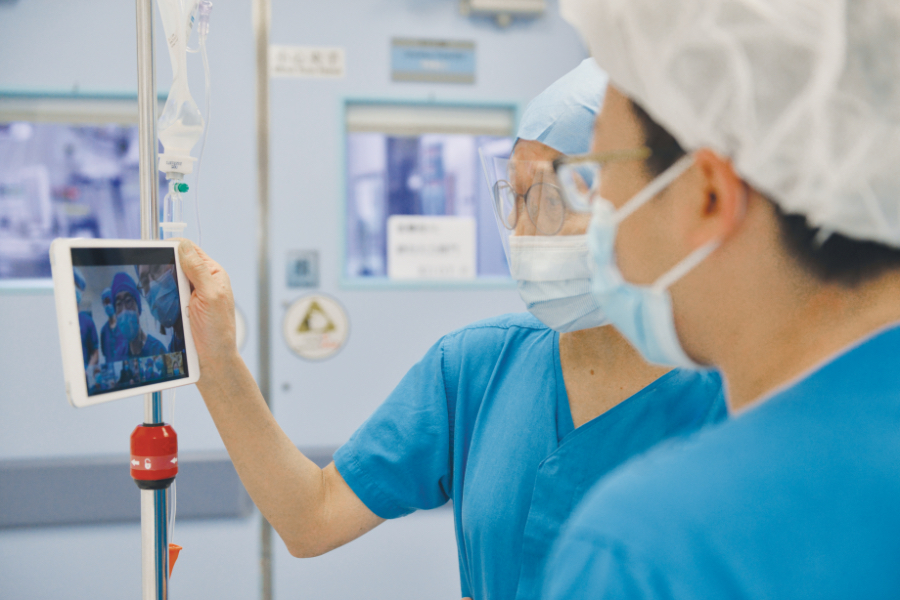The inside story of Hong Kong’s first paired kidney transplant

“The tablets are connected. We are ready.” The atmosphere inside the operating theatres at Princess Margaret Hospital (PMH) and Queen Mary Hospital (QMH) was so tense that you could cut it with a knife, as surgeons and nurses prepared for Hong Kong’s first paired kidney transplant.
“It’s 8.36 am and the donor is now under general anaesthesia.” A team of more than 10 people from each hospital made final preparations, adjusting the operating room lights and organising the equipment for a milestone moment in surgery.
The first incisions were made 40 minutes later. “It’s 9.15 am. We will now harvest the donor’s kidney,” says the surgeon. “Okay, we’re ready to cut at the same time,” comes the reply from the other side of tablets.
Two months after the groundbreaking operations, both surgeons have vivid memories of the morning and its unique challenges. “I have been performing surgery for over 20 years, but I never had an experience of communicating with doctors in another hospital in real time during surgery,” says Dr James Tsu, Director of Combined Renal Replacement Services of QMH, “luckily, the Wifi signal is pretty good.”
Dr Chu Tin-yu, Consultant of Department of Surgery of PMH says, “this unprecedented surgery carried the expectations of many people. We had many meetings across hospitals and departments, over a period of three months to rehearse the pre-operative and post-operative procedures, and to ensure that nothing went wrong.”
“It’s 8.36 am and the donor is now under general anaesthesia.” A team of more than 10 people from each hospital made final preparations, adjusting the operating room lights and organising the equipment for a milestone moment in surgery.
The first incisions were made 40 minutes later. “It’s 9.15 am. We will now harvest the donor’s kidney,” says the surgeon. “Okay, we’re ready to cut at the same time,” comes the reply from the other side of tablets.
Two months after the groundbreaking operations, both surgeons have vivid memories of the morning and its unique challenges. “I have been performing surgery for over 20 years, but I never had an experience of communicating with doctors in another hospital in real time during surgery,” says Dr James Tsu, Director of Combined Renal Replacement Services of QMH, “luckily, the Wifi signal is pretty good.”
Dr Chu Tin-yu, Consultant of Department of Surgery of PMH says, “this unprecedented surgery carried the expectations of many people. We had many meetings across hospitals and departments, over a period of three months to rehearse the pre-operative and post-operative procedures, and to ensure that nothing went wrong.”
Ensuring fairness and protecting privacy
Paired kidney transplantation involves the matching of two pairs of incompatible donors and recipients. Each donor gives a kidney to the other person’s intended recipient.
The procedure has two major features compared with typical live transplants: Firstly, to ensure fairness, both surgeries are performed at the same time; secondly, the identities of donors and recipients are kept strictly confidential to protect their privacy and to guarantee that donors participate voluntarily and have the right to withdraw at any time.
“The families involved in the operations were both from the Kowloon West Cluster,” explains Dr Catherine Chong, Senior Manager (Integrated Clinical Services) of the Hospital Authority.
“As paired kidney transplantation requires at least four simultaneous operating theatres, one donor and recipient were transferred to QMH in Hong Kong West Cluster so we could be sure of adequate resources and staff deployment, and to avoid a post-operative encounter at the hospital. It took a lot of coordination by Head Office with support from the Cluster Chief Executives.”
Dr Chong also led the Head Office team in communicating with the Human Organ Transplant Board. Given the legal and ethical considerations involved in live organ transplants, written approval was required for each operation. Because this was the first paired kidney transplant in Hong Kong and both donors and recipients were strangers, it was important to ensure that no coercion or commercial transactions were involved at any stage.
“We maintained close contact with different teams to ensure the accuracy of the information,” Dr Chong explains. “The goal was clear and consistent – to give two patients new leases of life.”
The procedure has two major features compared with typical live transplants: Firstly, to ensure fairness, both surgeries are performed at the same time; secondly, the identities of donors and recipients are kept strictly confidential to protect their privacy and to guarantee that donors participate voluntarily and have the right to withdraw at any time.
“The families involved in the operations were both from the Kowloon West Cluster,” explains Dr Catherine Chong, Senior Manager (Integrated Clinical Services) of the Hospital Authority.
“As paired kidney transplantation requires at least four simultaneous operating theatres, one donor and recipient were transferred to QMH in Hong Kong West Cluster so we could be sure of adequate resources and staff deployment, and to avoid a post-operative encounter at the hospital. It took a lot of coordination by Head Office with support from the Cluster Chief Executives.”
Dr Chong also led the Head Office team in communicating with the Human Organ Transplant Board. Given the legal and ethical considerations involved in live organ transplants, written approval was required for each operation. Because this was the first paired kidney transplant in Hong Kong and both donors and recipients were strangers, it was important to ensure that no coercion or commercial transactions were involved at any stage.
“We maintained close contact with different teams to ensure the accuracy of the information,” Dr Chong explains. “The goal was clear and consistent – to give two patients new leases of life.”
